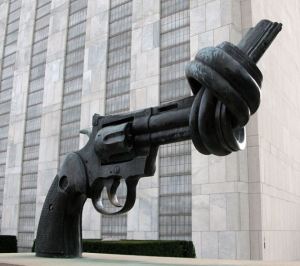
Karl Reutersward’s Twisted Gun Scuplture at the United Nations was made from melted down guns. Photo by Dan Nyugen
In light of the recent event in Aurora Colorado, it behooves us to re-examine the violent nature of our society where all too often the solution to one’s personal hurts seems to be go out and hurt someone else.
Why?
- It’s on the TV, on the movie screen, in the video games: According to the American Psychiatric Society over 1000 studies have shown a causal link between media violence and aggression in children. This correlation according to Dr. Michael Rich, Director of the Center on Media and Children’s Health at Boston’s Children’s Hospital is greater than that between calcium and strong bones, lead and lower IQs, and environmental cigarette smoke and lung cancer. Consider that the average child watches 25 hours of television or movies a week. By the age of 18 this child will have witnessed 2000,000 acts of violence, some dramatized and some, thanks to our avidity for news, real. There is no question that after watching the coverage of the mass mass murder in Aurora most young people can probably detail the killer’s actions.
- Our society worships guns: There are guns everywhere. In 2010 there were 300 million firearms owned by civilians in the U.S… This is out of a population of 309 million. There are guns in almost half the households in our country. And these are not merely hunting rifles, but weapons like the one used in Aurora that sprays hundreds of bullets so quickly that no altruistic person can pull down that gunman He or she will dead before getting close. All our heroes can do is throw their own bodies over their loved ones.
- We’re desensitized: Repeated exposure to violence increases our tolerance to it. Remember that famous experiment that had college students giving more and more powerful electric shocks to fellow students. [Watch the video below if you don’t] Lt. Colonel David Grossman, author of Stop Teaching Our Kids to Kill, compares violence to nicotine in cigarettes. We not only become addicted to blood, gore and the killing of living things, we come to crave more and more graphic experiences. No wonder the news reporters seemed unsurprised that the Aurora mass killing was associated with the most violent Batman movie yet—a movie so violent that some in the audience thought the killer was part of the movie!
What can you and I do about this?
We need to think about the things we do that support violence in our society and make a commitment to peaceful existence in our personal lives. Choose not to go to see Batman or other violent movies, turn off the TV and choose to walk in nature or visit with friends, study conflict resolution or practice meditation. Read about being peaceful to your children. Peaceful choices are bountiful if we pull away the screen of violence surrounding us daily.
Here are some books to share with children that value peace over violence:
For preschoolers
- No Hitting! By Karen Katz This colorful board book teaches little ones how to deal with angry feelings
For primary and intermediate grades
- Peace Begins with You by Katherine Sholes This books explains peaceful choices people can make through carefully described examples.
- The Pig War by Betty Baker (out-of-print but available used) This is the true story of the conflict between Britain and the U.S. in 1859 over an island in Vancouver Bay and how it was settled peacefully.
For middle grades
- Warriors by Joseph Bruchac In the wake of random sniper killings in Washington DC, a Native American boy teaches his classmates the ritual meaning of lacrosse as a way to find peace.
Learn more…
Statistics on Media and Violence


